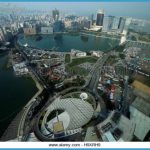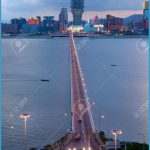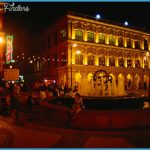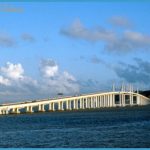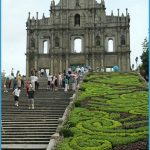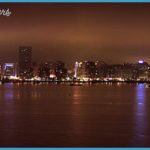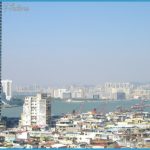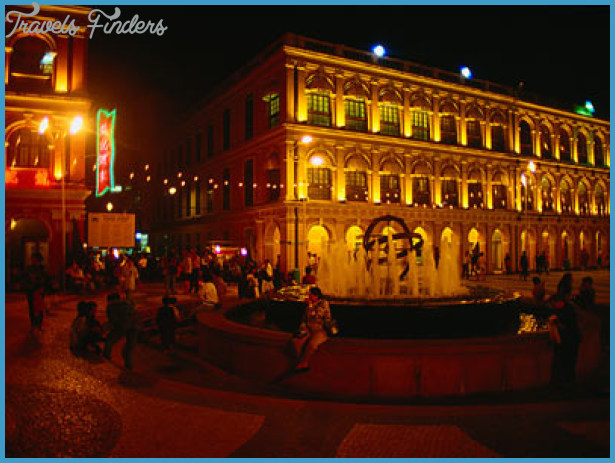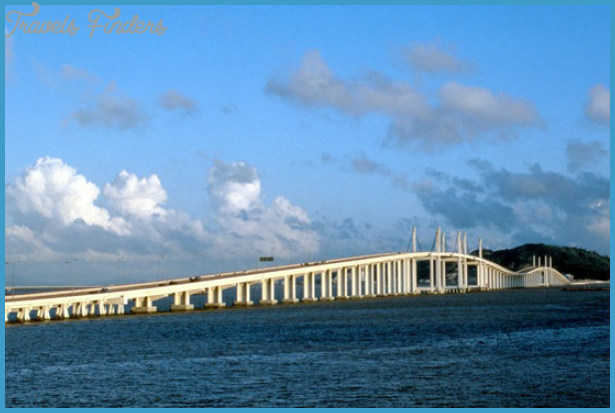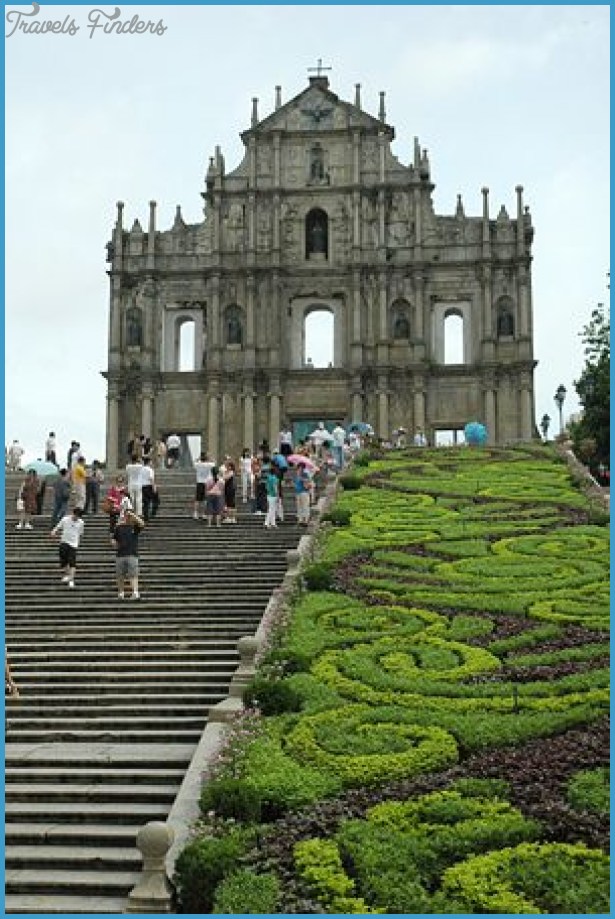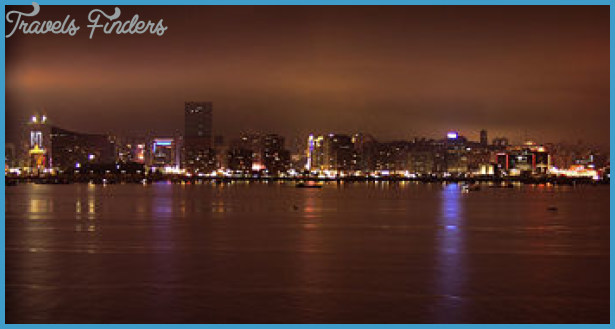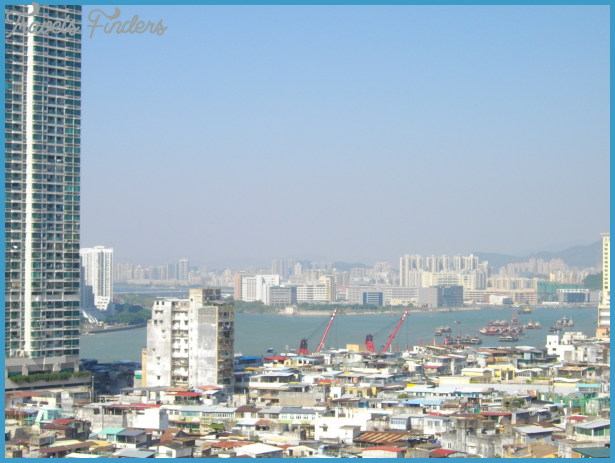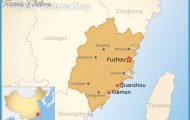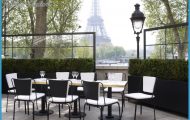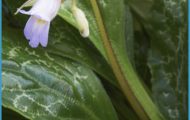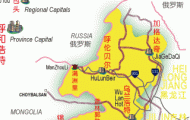Both from the Shun Tak Centre, the first terminal for ferry traffic to and from Hong Kong, situated in the Outer Harbour, and also from the new ferry terminal just to the north, it is possible to travel into the town centre by bus or taxi, and this is where most of the hotels are to be found. Just past the grandstand belonging to the motor-racing track one comes to the unusual Hotel Lisboa, where there is a monument to Governor Ferreira do Amaral, the founder of independent Macau.
Situated near the Outer Harbour is the Macau Forum, opened in 1985, a centre for culture, sports and leisure activities.
The broad tree-lined Rua da Praia Grande leads from near the Outer Harbour to the beach. Between the Hotel Lisboa and the Inner Harbour (home tothefloating casino Macau Palace) extending diagonally acrossthe whole of the peninsula, is the Avenida Infante Dom Henrique, later the Avenida Almeida Ribeiro, the most important shopping street in Macau.
In the centre the Avenida Almeida Ribeiro widens to become the Largo do Leal Senado, which is where the imposing senate building, the Leal Sen-ado, is located. The epithet “leal” (legal, loyal) was given to the senate of Macau because in 1809 it sent a battleship in support ofthe Portuguese royal court, which had had to flee to Brazil in the face of Napoleon’s advancing troops. The present senate building is supposed to have been built in 1784 on the site of an older building. The fagade was not added until
1870 and the complete building was completely restored in 1939-40. It encloses a charming inner courtyard; on the first floor is the council chamber and the library (a number of books dating back to the 16th c.)
At the north-eastern end of the square stands Santa Casa da Misericordia, the premises of a charitable institution set up in 1498. The Casa da Misericordia owes its inception to the Jesuit Dom Melchior Nunes Cameiro Leitao, the first Bishop of China and Japan. His head is preserved in a glass reliquary. A few steps to the east stands the Se Catedral (cathedral), built between 1844 and 1850 on the site of a 17th c. church and rebuilt in 1938. It is built in the style of a basilica with two sturdy towers. In a shrine above the chapel lie the relics of Japanese martyrs who died during the persecution of Christians in the early 17th c.
From the Leal Senado the Rua Central leads south-westwards to the Church of Santo Agostinho (St Augustine), the largest church in the area, which was built in 1586, renewed in 1814 and extensively rebuilt in 1875.
Opposite stands the Teatro de Dom Pedro V, which todays belongs to the Club de Macau. A short distance further on stands the Church of Sao Lourengo (St Laurence; originally 16th c. but substantially renovated during the 19th c.) with its Baroque-style interior. Extending up the hill behind lies the traditional old residential district of the town.
Directly behind the Church of Sao Lourengo stands the St Joseph Seminary with its church built between 1746 and 1758, the fagade of which is approached by a flight of steps. A museum of sacred art is housed here.
From Sao Lourengo a narrow street leads down to the Baia da Praia Grande, where the Palacio do Governo, the seat of government in Macau, a three-winged Classical building, is situated.
Running southwards from the Praia Grande towards the tip ofthe peninsula is a road which leads up to the hill or Penha with its chapel and Residencia Episcopal (bishop’s residence; at present unoccupied). Here there is a good view of the town and harbour; a little further down stands the pink-stuccoed Governor’s House.
A pathway around the tip of the peninsula (on thefar side ofthe walls ofthe former Fort Barra, in which the Pousada de Sao Taigo is now housed, and on the other side ofthe naval arsenal) leads to Ma Kok Temple, which is dedicated to the sea goddess A Ma. The temple, which is reputedly six hundred years old, is built on rock which was cut nearby. The colourfully painted relief of the ship by which the goddess is supposed to have landed can be seen here. Opposite the temple stands the Museu Maritimo de Macau (the Macau Nautical Museum).
On the west side of the peninsula (in the area to the north of the Porto Interior and the Avenida Almeida Ribeiro) lie the Camoes Gardens, from where there is a view across the Inner Harbour to the hills of the nearby Chinese mainland. The gardens boast a grotto dedicated to the great Portuguese poet Luis Vaz de Camoes (1524-80), who in all probability was living in Macau at the time of the city’s foundation.
On the same site as the gardens stands a building built about 1770 which once served as the administrative headquarters ofthe East India Company and from 1940 to 1992 contained a fine museum devoted to Camoes. As a result of a change of ownership ofthe building, the valuable artistic collections (including Kwantung ceramics and early 19th c. paintings) are being stored elsewhere and for the time being are not available for viewing.
Near the Camoes Gardens lies the old Protestant Cemetery with a total of 162 gravestones.
Probably the most famous site in Macau is the massive fagade of the Church of Sao Paulo, the only remaining part ofthe church which was built between 1601 and 1637 by Japanese Catholics underthe direction of Italian Jesuits and destroyed by fire in 1835. The impressive fagade displays a remarkable marriage of European and Far Eastern architectural styles and to examine all its details it is well worth having a pair of binoculars.
A good view of the whole building can be obtained from the former hill fort of Sao Paulo do Monte, which was established in 1620. In among the ruins of the fort stand several old guns.
Remains of the Fagade of Sao Paulo Guia Hill (174m/571ft) is also dominated by an old fort (1637). There is also a Guia Hill chapelanda lighthouse which began operations in 1865andistheoldestof Lighthouse its type along the Chinese coast. This is the highest point in Macau and offers a splendid view across the whole ofthe territory and the wide estuary View ofthe Pearl River.
To the north ofthe city centre, on the Avenida do Coronel Mesquita, stands the fascinating labyrinth-like Kuan Yin Temple, also known as Kun lam Tong. The interior contains some fine Buddha figures and a carved picture ofthe Goddess of Mercy in the main hall. In thetemple garden lies the stone slab on which the first treaty between China and the USA is purported to have been signed in 1844. There is also a legend which claims thetemple is consecrated to Marco Polo.
Further on northwards is the Lin Fong Temple, also known as the Lotus Temple. It was built by Taoists in 1592 and for a long time was used as a resting-place for travellers to China. At the entrance to the temple garden stone creatures from Chinese mythology stand guard.
-On the way back to the senate building a visit can be made to the memorial house of Dr Sun-Yat-sen (Mansao Evocativa de Sun-Yat-sen) on the Avenida Sidonio Pais. This Moorish-style building was built in memory of the founder of the first Chinese republic, Sun-Yat-sen (1866-1925), who for some time practised as a doctor in Macau. The actual house he lived in was subsequently used as a store for explosives and was actually destroyed by an explosion.
Further south the visitor will pass a monument commemorating the Portuguese victory over the Dutch fleet, which attacked Macau in 1622, and one to Vasco da Gama, who discovered the sea route to India.
Macau Archives The restored colonial buildings along the Avenida Conselheiro Ferreira de Almeida house archives comprising books, documents and extensive records on microfilm relating to the Portuguese colonial empire and the links between Macau and both the Portuguese motherland and its Asiatic neighbours.

